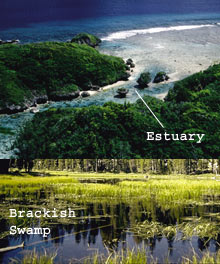
Half freshwater, half marine, brackish aquariums are home to some of the more stunning and unique fish in the hobby. This special niche is growing fast thanks to a better understanding of the brackish biotope and advancements in the equipment needed to welcome the costal estuaries and mangroves into your own home.
Better yet, despite their mystique, brackish aquariums are fairly easy to maintain since brackish inhabitants are conditioned to moderate fluctuations in water parameters from normal tidal cycles.
 The Brackish Biotope
The Brackish Biotope
Brackish habitats can be found in nature throughout the world where river deltas meet the ocean…estuaries, mangrove forests, or swamps. In a brackish habitat, salinity varies depending on the tide, the amount of freshwater entering from rivers or as rain, and the rate of evaporation. Water clarity can range from totally clear to murky. Water conditions range from 70-86°F, with a pH of 7.2-8.3, and a specific gravity ranging from 1.006-1.015.
Unique inhabitants of the brackish aquarium
Not all species of fish can adjust to ever-changing brackish conditions. Those fish that do are hardy, active, and easy to feed, making them a good choice for most enthusiasts. Setting up and maintaining a brackish aquarium for these fish is not difficult. In fact, a brackish set up is basically a freshwater aquarium that requires the addition of sea salt and ongoing testing to maintain specific gravity in a suitable range.
Fish
A few of the most popular brackish water species are:
- Black Sailfin Molly - This species should only share a tank with other peaceful fish.
- Mono Argentus - Diamond-shaped, silver in color, and has two black stripes on the front half; grows very large.
- Green Scat - Gradual change from brackish to saltwater will maximize the beautiful coloration of this fish as it matures.
- Archer Fish - Distinctive, triangular silver body; has the remarkable ability to spit water at insects above the water.
- Figure 8 Puffer - Unique coloration, appearance, and personality; when threatened can inflate to twice its normal size.
Click here for more on Brackish Water Fish.
Plants
Keeping even the hardiest of plants looking their best can be difficult in a brackish aquarium. The water movement preferred by brackish fish is not a plus for plants. And, since many brackish water fish are herbivorous, they don't hesitate to make a meal of their habitat.
One approach that helps ensure success is to begin by planting a freshwater aquarium. After the plants have had a chance to get well established, you can gradually increase the salinity over a period of several weeks, using a
hydrometer or
refractometer to measure the changes in specific gravity. Synthetic marine salt is recommended because of its consistency and purity.
Some of the best brackish water plant options include:

- Anacharis - Beautiful light to bright green leaves, with branching stems covered in bunches of linear, whorled leaves.
- Anubias - Lush green arrow-shaped foliage that is easy to grow; attaches itself to rocks, driftwood, substrate, and may even float.
- Hornwort - Sturdy, layered, hair-like foliage that helps oxygenate and clarify the water as well as keep algae growth to a minimum.
- Java Fern - Hardy and attractive; grows around 8 inches tall, with creeping, green rhizomes which can be tied to rocks and driftwood.
- Water Sprite - Very decorative and provides good contrast to other leaf shapes; delicate, lacy leaves also make great cover for fry.
For more on these and other plants suitable for Brackish water, visit our
Freshwater Aquarium Plants.
A Brackish aquarium can be exotic and beautiful. Don't be afraid to wade into the unique waters of this special hobby.
|